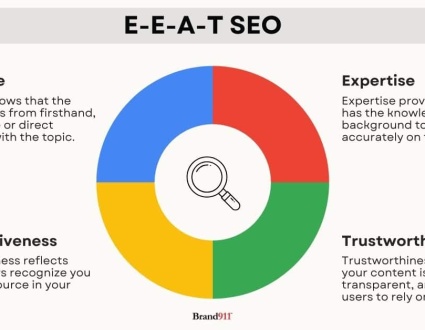Turn Reviews into Reputation Power
Your online reputation starts with what customers say about you. And those reviews? They’re more powerful than ads, and 93% of people read them before buying. (DataSeekers)
But only if you know how to manage them. Most businesses leave their review strategy to chance. Smart brands treat it as part of their reputation marketing.
Here’s how to leverage customer reviews for online reputation marketing:
- Encourage more feedback
- Monitor your reviews
- Respond to reviews
- Use the feedback to improve your business
- Showcase your best reviews

Why Customer Reviews Are the New Word-of-Mouth
Online reviews have replaced casual recommendations between friends. A single review now influences dozens—or thousands—of buying decisions. What people say about your business is public, permanent, and incredibly persuasive.
Reviews Influence Consumer Trust & Sales
Reviews build trust before a customer ever speaks to you.
- 98% of consumers read reviews for local businesses (ShoutAboutUs)
- 84% trust them as much as personal recommendations (Inc)
- 87% of consumers said that real-life customer reviews/ratings have a greater impact on purchasing decisions compared to influencer/celebrity reviews (Emplifi)
The number and tone of reviews matter. A ReviewTrackers study found that 94% of customers say negative reviews have convinced them to avoid a business.
And you don’t need a perfect 5-star score. Research from Spiegel Research Center found the optimal rating for conversions is between 4.2 and 4.5 stars—too perfect feels fake.
A consistent pattern of thoughtful reviews gives customers confidence. It also shows your business is active, engaged, and trustworthy.
Reviews Are Core Local Ranking Signals
Online reviews don’t just build trust—they also help people find you.
Google uses review signals as a major part of local search rankings. According to Bright Local, reviews account for about 17% of how Google ranks local results.
What matters most?
- Total number of reviews
- Average star rating
- Keywords used in reviews
- Frequency and recency of reviews
- Diversity across platforms (Google, Yelp, niche sites)
Businesses that consistently attract and respond to reviews are more likely to appear in Google’s local 3-pack—the map-based listings that show up above standard results. That’s prime real estate for attracting local customers.
More reviews → better rankings → more visibility → more customers → even more reviews. It’s a feedback loop that rewards consistency and good service.

How to Leverage Online Reviews (5 Tips)
1. Encourage more feedback
The best time to ask for a review? Right after a positive experience.
- Send a follow-up email or text within 24 hours of purchase or service
- Include a direct link to your review page (no login steps or extra clicks)
- For in-person businesses, use QR codes on receipts, menus, signage, or thank-you cards
- Add a “Review Us” call-to-action on your website footer, booking confirmation, or email signature
Train your staff to ask for reviews during high-satisfaction moments. A simple, “Would you mind sharing your experience online?” can go a long way.
You can also set up automated follow-ups through your CRM or booking system to keep the request consistent and timely.
Don’t offer incentives for leaving reviews. Most platforms, including Google and Yelp, prohibit this. Stick with honest requests and make the process as easy as possible. That’s what builds real, lasting trust.
2. Monitor your reviews
You can’t leverage what you don’t see.
Online reviews live on multiple platforms—Google, Yelp, Facebook, TripAdvisor, and industry-specific sites. If you’re not checking regularly, you’re missing valuable feedback and opportunities to respond.
- Use tools like Google Alerts, ReviewTrackers, or Birdeye to track reviews across all major sites in one place
- Set up real-time notifications so you’re alerted the moment a new review is posted
- Pay attention to patterns—Are complaints about customer service on the rise? Are certain locations getting more praise than others?
Keep an eye out for recurring themes and tones. Smart businesses use AI-powered sentiment tools to analyze trends over time. This can help you spot issues before they escalate—or double down on what’s working.
Even with automation, the human element matters. Read every review yourself or assign a team member to do it. A thoughtful response starts with understanding what was actually said.
Monitoring reviews consistently helps you stay ahead of reputation issues and identify wins you can use in your marketing.
3. Respond to reviews
Every review deserves a response—positive or negative. Thoughtful replies show future customers that you’re listening, professional, and committed to service.
For positive reviews:
- Thank the customer by name
- Mention something specific from their comment
- Reinforce your brand personality or share a next step (“We’re so glad you loved the pasta—can’t wait to welcome you back for truffle season!”)
A personal touch turns a happy customer into a repeat customer—and an advocate.
For negative reviews:
- Acknowledge the issue within 24–48 hours
- Apologize sincerely and offer a clear solution
- Take the conversation offline when needed, then follow up after resolution
The goal isn’t to win the argument—it’s to show empathy and accountability.
Customers are paying attention. According to GatherUp, 82% of people are more likely to choose a business that responds to reviews. Even a negative review handled professionally can build more trust than no review at all.
And if you resolve the issue well, ask if the customer would consider updating their review. Many will—especially if they feel heard and respected.
4. Use the feedback to improve your business
Online reviews are more than ratings—they’re free market research written in your customers’ own words.
- Look for recurring complaints—those are red flags you can’t ignore
- Track praise too—what are people loving? That’s your competitive edge
- Tag and categorize feedback by topic (e.g., service, wait times, shipping, website usability)
- Share trends with your team in regular “Voice of the Customer” updates to guide training, product improvements, or policy changes
Make the improvements visible. When you act on feedback and let customers know, it builds trust and loyalty:
“Thanks to your feedback, we’ve extended our customer service hours.”
“You spoke, we listened: Our new return process is now hassle-free.”
Follow up when possible. If you fixed something a customer complained about, reach out to let them know. Many will revise or remove a negative review when they see you’ve taken real action.
Over time, this feedback loop turns your reviews into a roadmap for smarter decisions—and a stronger business.
5. Showcase your best reviews
Great reviews shouldn’t be buried on third-party sites. If customers are saying good things about your business, put that social proof front and center.
- Feature testimonials on your homepage, product pages, landing pages, and service pages
- Add a rotating review widget or a static section with 3–5 curated quotes
- Use short snippets in email footers, newsletters, and proposals to build trust passively
- Create visual content—turn 5-star reviews into eye-catching graphics for Instagram, Facebook, and LinkedIn (just get customer permission if you’re using names or photos)
- Match reviews to use cases: For example, a skincare brand might display reviews by skin concern (dryness, acne, sensitivity) to improve conversion
Don’t forget video. A 30-second customer testimonial can be more powerful than any sales script. Even a casual video filmed on a phone can feel more authentic than polished brand content.
Set a reminder to refresh your featured reviews every quarter. Outdated praise can make your business feel stagnant. New reviews keep your credibility current and your marketing content fresh.
Frequently Asked Questions about Customer Review Management
How fast should I respond to reviews?
Aim to reply within 24–48 hours. Quick responses show customers you’re paying attention, especially when handling negative feedback. If you need time to investigate an issue, acknowledge the review right away and follow up with a solution. Prioritize negative or critical reviews first—but don’t ignore the positives. Even a short thank-you helps build goodwill.
Can I offer incentives for reviews?
Yes, but be careful. You can reward customers for leaving a review—not for what they say. Any incentive should apply equally to all customers and follow platform policies (Google allows it, Yelp prohibits it). Transparency is key: if you offer something in exchange, ask customers to disclose that in their review.
How can I spot fake reviews?
Look for vague language, extreme tone, or patterns—like multiple negative reviews in a short period. Check the reviewer’s profile for signs of spam (new account, no history, only reviews of competitors). If you suspect a fake, report it with detailed evidence: screenshots, timestamps, and any proof the reviewer wasn’t a customer.
Do negative reviews always hurt my reputation?
Not if you handle them well. Responding calmly and professionally can actually boost trust. Many customers will revise or remove a bad review if their concerns are resolved. In fact, some of the most loyal fans start as unhappy customers who feel heard and helped.
What review platforms matter most?
Focus on where your customers search: Google is #1 for local businesses, followed by Yelp, Facebook, and industry-specific platforms. Tools like Birdeye or ReviewTrackers can help you monitor them all in one place.
Conclusion & Next Steps
Online reviews are no longer just feedback—they’re fuel for your brand. When used strategically, they boost trust, improve search visibility, and drive new business.
Key Takeaways:
- Ask for reviews right after a positive experience
- Monitor and respond to every review—quickly and professionally
- Use feedback to guide business improvements
- Highlight your best reviews across your website and social channels
- Keep your local search presence strong with consistent review activity
Brand911 helps you turn customer reviews into real marketing power. Our Local Digital Marketing services focus on improving your search rankings, building credibility, and helping new customers find you fast.
Ready to grow your visibility and trust in your local market?
Request a free quote and let Brand911 create a strategy tailored to your business.
About us and this blog
We are a digital marketing company with a focus on helping our customers achieve great results across several key areas.
Request a free quote
We offer professional SEO services that help websites increase their organic search score drastically in order to compete for the highest rankings even when it comes to highly competitive keywords.
Subscribe to our newsletter!
More from our blog
See all postsRecent Posts
- E-E-A-T SEO: What It Is, Why It Matters, and How to Build It December 12, 2025
- 15 Personal Branding Mistakes That Hold You Back (And How to Fix Them) December 9, 2025
- Google AI Overviews vs Featured Snippets: What They Mean for Your SEO December 4, 2025














Recent Comments